Creating high-ranking articles requires more than just good writing—it demands a solid understanding of SEO and content optimization. NeuronWriter is a powerful tool designed to help you master both.
By using its AI-driven insights, you can craft content that ranks higher on search engines, engages readers, and stays ahead of competitors. In this guide, we’ll walk through the best NeuronWriter tips that will enhance your content and boost your chances of ranking on the first page of Google.
Table of Contents
What are the Best NeuronWriter Tips for Creating High-Ranking Articles?
To create high-ranking articles using NeuronWriter, focus on comprehensive keyword research, structuring content for search engines, and optimizing for featured snippets. Use AI-driven insights, semantic keywords, and real-time SEO scores to continuously improve your article’s performance.
By following these strategies, you can streamline your workflow and significantly enhance the quality of your written content, making it more SEO-friendly and engaging for readers.
Start with Competitor Research
The foundation of any high-ranking article is thorough keyword research. NeuronWriter helps you identify high-traffic keywords and provides keyword difficulty scores to help you choose the right ones.
By understanding what works for competitors, users can refine their content strategy, generate new article ideas, and identify opportunities to improve their own writing.
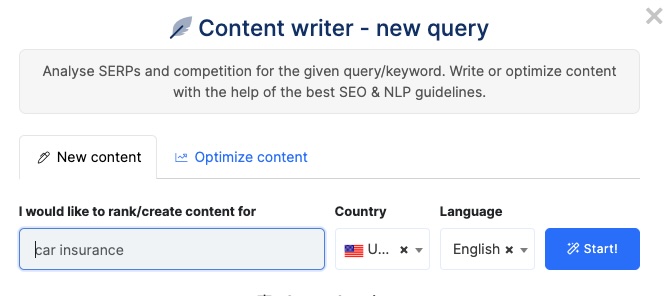
Competitor research enables users to:
- Analyze keyword usage effectively
- Identify popular topics within their niche
- Examine the style and tone that resonates best with their audience
- Start a new “Query”, enter your main topic, and NeuronWriter will scan the top 30 ranking articles.
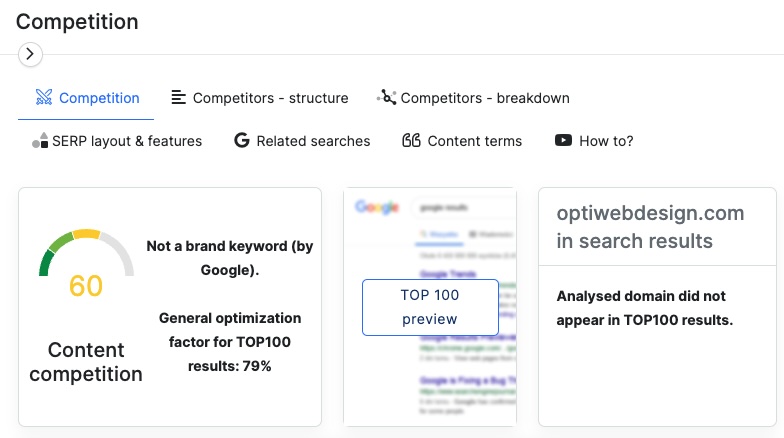
- Competitor Analysis: Use NeuronWriter’s competitor analysis tool to see which competitors are ranking for your chosen keyword.
- Find Long-Tail Keywords: Click on “Competition” and “Related Searches” to see long-tail keywords that are more specific and potentially easier to rank for. For example, if you’re writing about “seo content,” NeuronWriter might suggest “seo content examples” as an option.
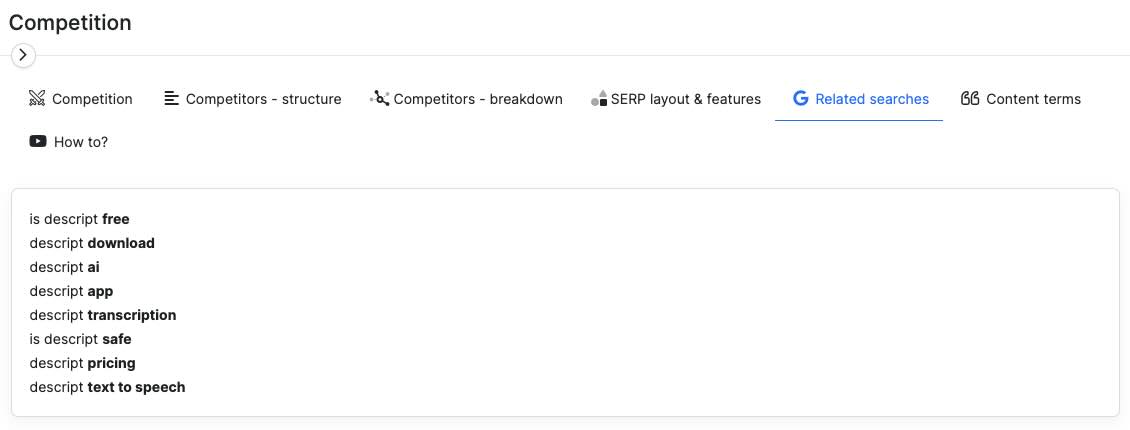
By dissecting elements such as content engagement metrics and utilizing semantic SEO techniques, users can enhance overall content quality, tailoring their own pieces to meet and exceed audience expectations.
Use NeuronWriter’s AI to Create an Optimized Content Structure
A well-structured article is essential for both user experience and SEO. NeuronWriter’s AI helps you organize your content so it’s easy for readers to follow and optimized for search engines.
- Create an SEO-Friendly Outline: NeuronWriter’s AI can generate a comprehensive, logical structure based on your topic. For example, if you’re writing about “fitness tips for beginners,” NeuronWriter might suggest an outline with sections like “Setting Fitness Goals,” “Choosing the Right Exercises,” and “Tracking Your Progress.”
- Click on “AI-writing” in the right panel, “Article outline” and enter your keyword to generate an outline.
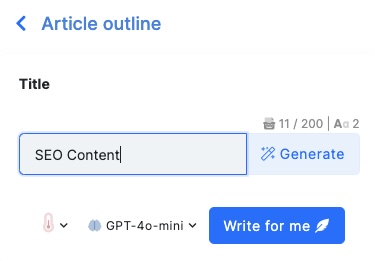
- Use Headings and Subheadings: Break your content into sections with clear H1, H2, and H3 tags. NeuronWriter highlights where to place your primary and secondary keywords in these headings. For example, an H2 could be “Best Fitness Tips for Beginners,” while an H3 could be “How to Set Realistic Fitness Goals.”
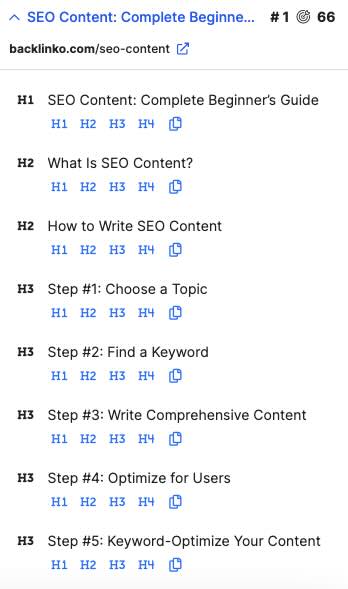
- Content Flow: Make sure each section logically follows the previous one. NeuronWriter’s AI ensures that the flow of information is natural and aligned with user intent. For instance, after discussing “Choosing the Right Exercises,” you could seamlessly lead into “Tracking Fitness Progress” by using transition phrases like “Once you’ve selected your exercises, it’s important to track your progress.”
- Get started with NeuronWriter
Use the Keyword Suggestions and Focus on Keyword Density and Placement
Effective keyword usage is crucial for ranking. NeuronWriter helps you maintain the right keyword density and guides where to place them for maximum SEO impact.
To improve SEO optimization, it’s essential to fully utilize the keyword suggestions feature of NeuronWriter, which identifies relevant keywords that align with audience intent. Incorporating these suggestions into your content can drive organic traffic and enhance your Google ranking by identifying NLP keyword patterns.
When considering how to integrate these suggestions, think about the following:
- Ensure the keywords flow naturally within sentences, avoiding awkward phrasing.
- Prioritize primary keywords, but don’t neglect secondary ones, which can also capture niche audiences.
- Utilize keywords in metadata, such as title tags and alt texts for images, which aids in search engine indexing.
Steps to follow:
- Maintain Ideal Keyword Density: NeuronWriter calculates the keyword density as you write. Aim for a density of 1-2%, which is considered optimal. For example, if you’re writing a 1,000-word article on “healthy eating tips,” NeuronWriter will suggest using the primary keyword 10-20 times throughout the content.
- Strategic Keyword Placement: Place primary keywords in the most important areas: title, first paragraph, headings, and conclusion. NeuronWriter highlights these key spots. For example, in an article on “digital marketing strategies,” your title might be “Top Digital Marketing Strategies for 2024” and the keyword “digital marketing strategies” should appear in the first sentence and at least one subheading.
- Avoid Keyword Stuffing: NeuronWriter alerts you if you’re overusing keywords, which can hurt SEO. Use keywords naturally and sprinkle them throughout the article. Instead of repeating the same keyword, use semantic keywords (LSI). For example, instead of constantly saying “healthy eating tips,” you can also use phrases like “nutrition advice” or “healthy diet strategies,” which NeuronWriter can suggest.
By optimizing your content this way, the potential impact on visibility is significant, resulting in higher engagement rates and improved overall performance.
Optimize for Featured Snippets
Featured snippets are prime real estate on Google, and NeuronWriter can help you format your content to increase the chances of landing one. Snippets appear at the top of search results and provide quick answers to user queries.
- Answer Questions Directly: NeuronWriter helps you identify common questions related to your topic. For example, if your article is about “how to start a blog,” include a concise answer in the first 40-60 words of a section. Example: “To start a blog, choose a platform, create a content plan, and write engaging posts regularly.”
- Use Lists and Tables: Google often prefers structured data like bullet points, lists, and tables for snippets. NeuronWriter can suggest formatting tips to turn your content into snippet-friendly formats. For example, if writing about “best SEO tools,” use a bulleted list:Example:
- Best SEO Tools:
- Ahrefs
- Semrush
- NeuronWriter
- Include “How-to” Guides: Google frequently pulls step-by-step instructions into snippets. NeuronWriter can help you structure content to answer “how-to” queries. Example: “How to Start a Blog in 5 Steps: 1. Choose a niche, 2. Select a platform, 3. Register a domain, 4. Design your blog, 5. Publish your first post.”
By formatting your content using NeuronWriter’s suggestions, you increase your chances of appearing in a featured snippet, driving more traffic to your site.
Use Semantic Keywords to Improve Content Relevance
Using semantic keywords (LSI keywords) helps search engines understand the context of your article, making it more relevant to a wider range of searches. NeuronWriter suggests related terms that enhance your content’s depth and accuracy.
- Identify Semantic Keywords: NeuronWriter provides a list of semantic keywords related to your primary keyword. For example, if you’re writing about “SEO content,” NeuronWriter might suggest keywords like “SEO writing,” “content strategy,” or “basic of SEO.” These terms ensure your content covers all related topics search engines expect to see.
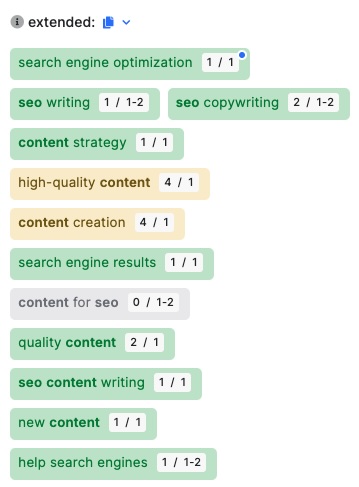
- Integrate Naturally: Include semantic keywords naturally throughout your article to boost relevance without overstuffing. For instance, in an article about “healthy eating,” after introducing the primary keyword, NeuronWriter might suggest using LSI terms like “balanced diet,” “nutritious meals,” or “meal planning.”
- Use in Key Areas: Place semantic keywords in headings, subheadings, and body text. For example, an H2 heading might be “Best Online Marketing Tactics,” while an H3 could be “Effective SEO Techniques for Small Businesses.” NeuronWriter will guide you on where these keywords fit best.
Using semantic keywords ensures your content covers the topic comprehensively, improving your chances of ranking for various search queries related to your main keyword.
Improve Readability with NeuronWriter’s NLP Features
Readability is a key factor in both user engagement and SEO. NeuronWriter’s Natural Language Processing (NLP) tools help you write content that’s easy to read while maintaining SEO effectiveness.
- Simplify Your Language: NeuronWriter analyzes the complexity of your writing. Aim for simple, clear sentences. For example, instead of writing, “The implementation of SEO strategies can significantly enhance your website’s visibility,” simplify it to “SEO strategies can help your website get noticed.” This keeps your content accessible to a wider audience.
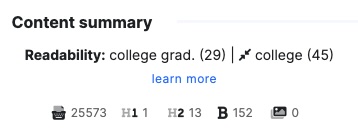
- Shorter Sentences and Paragraphs: NeuronWriter suggests breaking long sentences into shorter ones for better readability. Keep paragraphs to 2-3 sentences to avoid overwhelming readers. For example, instead of a large block of text explaining “how SEO works,” split it into multiple short paragraphs that each focus on a specific aspect, like keywords, backlinks, or meta tags.
- Use Transition Words: NeuronWriter highlights the importance of transition words (e.g., “first,” “next,” “in addition”). These improve flow and help guide the reader through the content. For instance, when explaining steps in a guide, you can start sentences with “First, choose your topic,” followed by “Next, create an outline,” and so on.
By using NeuronWriter’s NLP features, you ensure that your content is easy to read, skimmable, and engaging, improving both user experience and SEO performance.
Follow the SEO Recommendations
NeuronWriter’s real-time content scoring is a powerful tool that guides you in creating SEO-optimized content. The score reflects how well your article is structured and optimized for search engines, ensuring you hit all the key SEO elements.
Following the SEO recommendations provided by NeuronWriter is crucial for achieving optimal content curation and performance. These guidelines will help ensure that your writing is not only engaging but also aligned with current SEO best practices, improving your overall semantic SEO strategy.
This practice not only improves readability but also signals to search engines the main themes of the content, utilizing NeuronWriter’s AI features and content editor.
- Utilizing headers correctly can aid in structuring content, making it easier for readers to digest.
- Incorporating internal and external links enriches the text while boosting its authority.
- Regularly updating content ensures it remains fresh and reflective of current trends.
- Monitor Your Score: As you write, NeuronWriter provides a real-time score that evaluates your content based on SEO best practices. Aim for a score of 70 or higher for a well-optimized article. For example, if your content scores low in keyword usage, NeuronWriter will notify you, allowing you to adjust the text immediately.
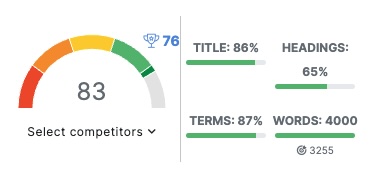
- Fix Issues as You Go: NeuronWriter highlights specific areas for improvement, such as keyword density, readability, and content structure. If the score drops due to low keyword usage, simply add more relevant keywords based on NeuronWriter’s recommendations. If the readability score is low, shorten sentences and use simpler language, as suggested by the tool.
- Track Changes in Real-Time: As you implement the changes, the score updates instantly, showing how your optimizations are affecting the overall SEO quality. This immediate feedback allows you to tweak and refine your article without guessing. For instance, if you add more headings, NeuronWriter will increase the score, confirming you’re on the right track.
Using NeuronWriter’s content scoring ensures you stay focused on creating SEO-friendly content that meets search engine requirements, improving your chances of ranking higher.
Conduct Competitor Analysis for Better Insights
Analyzing your competitors helps you identify opportunities and gaps in your content strategy. NeuronWriter’s competitor analysis tool allows you to see what’s working for top-ranking articles and how you can improve your content to outrank them.
- Identify Key Competitors: NeuronWriter lets you enter your target keyword and generates a list of competitors already ranking for that keyword. For example, if you’re targeting “social media marketing strategies,” NeuronWriter will show you the top-ranking articles for this keyword.
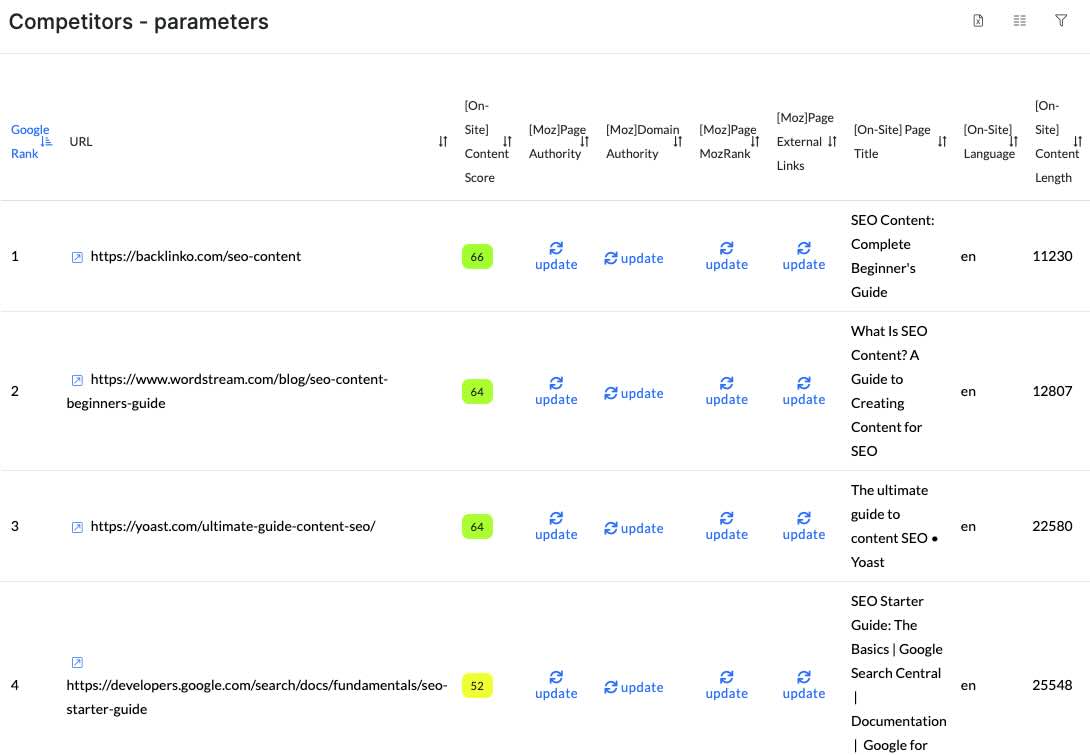
- Analyze Competitor Content: Review the structure, length, and keyword usage of competitor articles. NeuronWriter highlights areas where their content performs well, such as high keyword density or thorough topic coverage. For example, if a competitor has a detailed section on “Instagram marketing tips” and you don’t, that’s a gap you can fill.
- Spot Missing Elements: Look for areas where competitors fall short. If their article lacks depth in a particular section, you can expand on that topic. NeuronWriter will help you identify these gaps, such as competitors having weak internal linking or not covering a key subtopic like “social media marketing for small businesses.”
- Create Better Content: Use NeuronWriter’s suggestions to fill in content gaps, add more detailed subheadings, or improve your keyword usage compared to competitors. For example, if their article focuses on general strategies, yours can go deeper by including case studies or actionable tips.
By conducting competitor analysis through NeuronWriter, you can refine your content to address gaps and provide more value, giving your article a better chance of ranking higher.
Optimize Meta Tags and Descriptions with NeuronWriter
Meta tags and descriptions play a crucial role in how search engines and users perceive your content. NeuronWriter helps you craft optimized meta titles and descriptions that improve click-through rates (CTR) and visibility in search results.
- Create a Compelling Meta Title: NeuronWriter has a meta data generator to create optimal meta titles based on your target keywords. Keep the title under 60 characters and ensure it includes the primary keyword. For example, if your article is about “email marketing strategies,” a good meta title could be “Top Email Marketing Strategies to Boost Engagement”.
- Write a Concise Meta Description: Your meta description should summarize the article and entice users to click. NeuronWriter helps ensure that your meta description includes key phrases and stays within the 160-character limit. For example: “Learn the best email marketing strategies to increase open rates and drive conversions in 2024.”
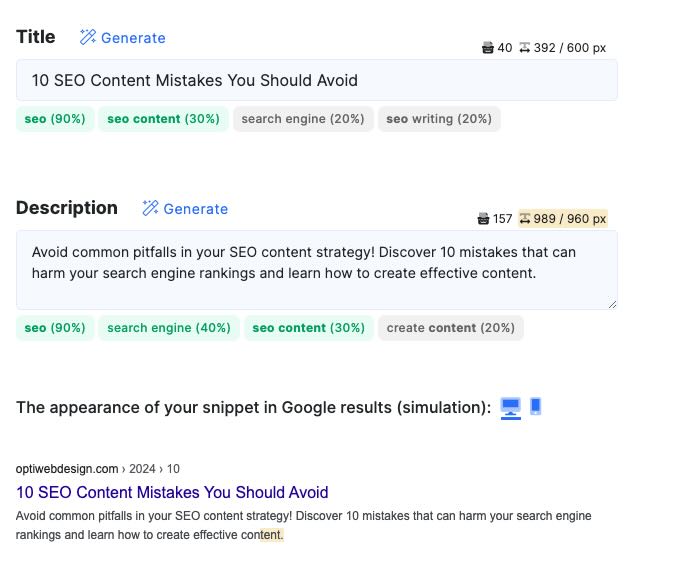
- Incorporate Primary Keywords: Ensure your primary keyword appears naturally in both the meta title and description. NeuronWriter will flag if the keyword is missing or not prominent enough. For instance, for an article on “content marketing tips,” the meta description might read: “Discover expert content marketing tips to boost your online visibility and grow your audience.”
- Boost CTR with Actionable Language: NeuronWriter can suggest adding action-oriented words like “learn,” “discover,” “find out” to improve CTR. For example, “Discover the top email marketing strategies for 2024” is more likely to attract clicks than a generic description.
By optimizing meta tags and descriptions with NeuronWriter, you improve both search engine visibility and user engagement, making it more likely that your content will get clicked and rank higher.
Customize the AI Settings
Customizing the AI settings in NeuronWriter allows users to tailor the writing assistant to their specific needs, enhancing the overall writing experience. By adjusting parameters such as tone, style, and focus, users can produce content that resonates more effectively with their target audience. These settings help align the content with your brand voice while leveraging the power of GPT-3 and GPT-4 technologies.
In doing so, they not only ensure that the output aligns with their unique brand voice but also capture the intended emotional response from readers. For instance, when the user selects a more conversational tone, it can create a welcoming atmosphere that encourages engagement. Conversely, a formal tone may suit professional documentation better.
Understanding how to optimize these settings is crucial, as they directly influence the quality and clarity of the generated content.
- Adjusting tone can enhance reader relatability.
- Tweaking style to match market trends increases relevance.
- Focusing on specific themes ensures cohesive messaging.
Ultimately, these personalized settings can lead to improved readability and greater audience connection, significantly boosting the effectiveness of the writing endeavor.
Regularly Update and Re-optimize Content
Search engines favor fresh, updated content. NeuronWriter helps you reoptimize your existing articles, ensuring they stay relevant and competitive in search rankings.
- Identify Outdated Content: Use NeuronWriter’s content analysis tool to review articles that are outdated or underperforming. For instance, if you wrote an article on “SEO trends 2022,” update it to reflect “SEO trends 2024,” adjusting the data and examples accordingly.
- Refresh Keywords: Search trends change over time, and so do the best-performing keywords. NeuronWriter suggests new keywords to target based on current trends. For example, if an older article on “digital marketing tools” ranks for outdated tools, NeuronWriter might recommend incorporating keywords for newer tools like “AI-driven marketing platforms” or “social media automation tools.”
- Update Content for Accuracy and Relevance: Ensure your content is still accurate. Update any outdated statistics, references, or recommendations. For instance, if a section on social media marketing tips references an algorithm change from 2021, update it to reflect the latest 2024 updates, improving your article’s relevance.
- Improve Content Depth: NeuronWriter can flag sections where competitors have added more depth. If your older articles lack detailed sections, expand on them using new subheadings, case studies, or examples. For example, if your article on “email marketing tips” doesn’t cover automation, add a section like “How to Use Automation in Email Marketing”.
- Reoptimize Meta Tags and Descriptions: NeuronWriter will also suggest updating meta tags and descriptions based on new keyword insights. For example, you could refresh the meta description to include trending keywords like “AI-driven email marketing” instead of outdated terms.
By regularly updating and reoptimizing your content with NeuronWriter, you can maintain high rankings and ensure your articles stay competitive and relevant.
Use the Built-in Editing Tools
NeuronWriter’s built-in editing tools are instrumental in enhancing content quality and ensuring clarity in writing. These tools are especially beneficial for creating eBooks and other long-form content.
These innovative features not only facilitate the meticulous examination of grammar but also offer style suggestions tailored to the user’s specific writing goals. By utilizing this cutting-edge technology, creators can identify inconsistencies and improve overall coherence, ensuring the final product is ready for platforms like WordPress.
The range of tools available includes:
- Real-time grammar checks
- Readability scores
- Style enhancement suggestions
Conclusion
Mastering NeuronWriter’s features can significantly improve your content’s SEO performance. From thorough keyword research to optimizing for featured snippets, NeuronWriter offers a complete toolkit for creating articles that rank high and attract organic traffic. Regularly updating your content and leveraging AI-driven suggestions ensures your articles remain competitive in an ever-changing digital landscape. Start applying these tips to see tangible improvements in your rankings and online visibility.
Related Posts:
- How to Use NeuronWriter Content Planning Tools
- What are the Best NeuronWriter AI Settings for SEO Content?
- How to Use NeuronWriter with Zapier
- SEO and NLP features of NeuronWriter
- NeuronWriter Beginner’s Guide to AI Content Optimization
- NeuronWriter Writing Style and Tone: 5 Ways This AI-Powered Tool Maintains Consistency
- How to Use NeuronWriter for Content Creation
- Mastering NeuronWriter Advanced Strategies
- How to Optimize Content With NeuronWriter Semantic Models
- Mastering SERPs: How to Use NeuronWriter for SERP Analysis